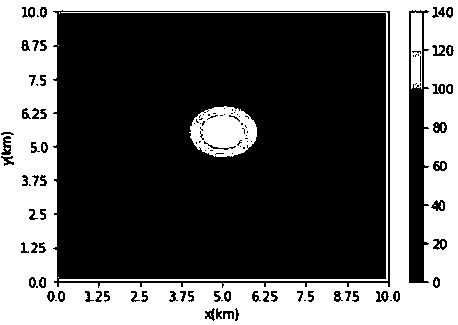Gravity field density inversion method based on quasi-radial basis function neural network
A neural network and density inversion technology, applied in the measurement of gravitational fields, measurement devices, instruments, etc., can solve the problems of inability to improve the vertical resolution of gravity inversion, ill-posed gravity inversion, etc., and achieve improved vertical resolution. and reliability, interpretability clear and well-defined effects
- Summary
- Abstract
- Description
- Claims
- Application Information
AI Technical Summary
Problems solved by technology
Method used
Image
Examples
Embodiment 1
[0049] The gravity field density inversion method based on the pseudo-radial basis function neural network adopts the following steps:
[0050] 1. Establish a gravity observation system
[0051] The coordinates of the two-dimensional observation system are (X, Z), X is the horizontal coordinate, Z is the elevation of the observation point; the coordinates of the three-dimensional observation system are (X, Y, Z), X and Y are the horizontal coordinates perpendicular to each other, Z is the elevation of the observation point; the observation system can be a plane observation system, that is, Z is a constant, or a curved surface observation system, and the observation points can be distributed at equal intervals or randomly distributed at unequal intervals;
[0052] 2. Establish a grid model
[0053] Divide the inversion target area into grids, the 2D inversion grids are rectangular, the 3D inversion grids are upright hexahedrons, and the grid data format is divided into (X 1 ,...
Embodiment 2
[0077] The present invention will be further described below in conjunction with specific examples.
[0078] The three-dimensional combined model is used to test the inversion effect of the method. The subdivision range of the underground half space is x direction: 0-9240 meters, y direction: 0-9240 meters, z direction: 0: 3040 meters, and each direction is divided into 10 grid, set two geological bodies, the density of geological body 1 is 1.0g / cm 3 , the distribution grid is x direction: 4~6, y direction: 3~5, z direction 2~4, the density of geological body 2 is 3.0g / cm 3 , the distribution grid is x direction: 4~6, y direction: 4~6, z direction 5~7, observation system range x direction: 0~10000 meters, y direction 0~1000 meters, observation point height is 0 meters, The distance between observation points in each direction is 500 meters, and there are 400 observation points in total. The model and simulated observation data are as follows: image 3 and Figure 4 shown. ...
PUM
 Login to View More
Login to View More Abstract
Description
Claims
Application Information
 Login to View More
Login to View More - R&D
- Intellectual Property
- Life Sciences
- Materials
- Tech Scout
- Unparalleled Data Quality
- Higher Quality Content
- 60% Fewer Hallucinations
Browse by: Latest US Patents, China's latest patents, Technical Efficacy Thesaurus, Application Domain, Technology Topic, Popular Technical Reports.
© 2025 PatSnap. All rights reserved.Legal|Privacy policy|Modern Slavery Act Transparency Statement|Sitemap|About US| Contact US: help@patsnap.com



